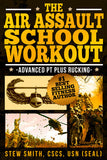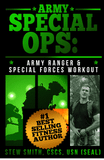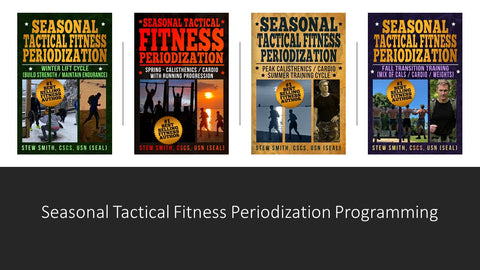Shin Splints (Medial Tibial Stress Syndrome)
By Seth Donelson (Doctor of Physical Therapy)

It never fails, emails and DMs blow up every Spring (well about a month into Spring) concerning shin splints. Learn more about your new nemesis and "fix your shin splints."
This article was submitted by our local Physical Therapist Seth Donelson who trains with my group here in Maryland. Not only are we excited to have him join us and experience our workouts, but also he assists by providing common injury articles such as this:
Overview:
This document covers basic information about how shin splints occur, how to identify them, and ideas to guide treatment and prevention. There are 2 graphics that summarize the risk factors for shin splints and identification/treatment, but I highly recommend you review the written information as it contains more detailed information. This is not a substitute for medical care or advice. If you’re unsure of the severity of your condition or feel it may be more serious, then seek out professional medical care.

Pathophysiology and Risk Factors:
Shin splints, formally known as Medial Tibial Stress Syndrome (MTSS), are typically classified as early stress injuries. Stress injuries are generally believed to be on a continuum with shin splints being the least severe while stress fractures are the most severe (1). Shin splints are stress reactions that occurs from the muscles of the lower low pulling on the tibia (shin). This pulling action causes inflammation and remodeling on the outer surface of the bone. This process is normal, but shin splints occur when the bone cannot remodel fast enough, typically due to overtraining. (1,2,3)
Factors that are consistently linked to increased risk for stress injuries are significant increases in bone loading (i.e. dramatic increase in running volume or intensity), lack of calf flexibility, high Body Mass Index (BMI), increased pronation/arch collapse of the foot, a history of MTSS, inadequate nutrition, and inadequate recovery (1,2). Additional items to be considered are that weak muscles can absorb less impact during running and asymmetries between legs (foot strike pattern, strength, flexibility) may lead to differences in loading/impact capacity and altered running mechanics (3).
Prevention: (What Most People Get Wrong)
This is arguably the most important section to read. As there is not a best course for treating shin splints, preventing them is of the utmost importance. The key to prevention is gradual exercise progression and ensuring that you’re eating and resting enough to recover from your workout. You’ll want to be familiar with the 10% rule as this is going to guide your exercise progression.
-
10% Rule - don’t increase your running and/or weight-lifting volume, intensity, or frequency by more than 10% per week. An example would look like this: you can run 10 miles a week while still feeling healthy and injury free; it’s safe and reasonable to add another mile next week or to increase your pace for one of your shorter run days by 1 mile (10%).
-
Nutrition – It’s generally recommended to consume 0.6 – 1.0 g/lbs of protein (1.4–2.0 g/kg), approximately 30% of your calories from fat, and the rest of your calories from carbohydrates. A sample from a 2000 calorie diet and 160 lbs person would look like this:
- Protein – 384 – 640 calories or 96 to 160 grams
- Fat – = 600 calories or 67 grams
- Carbohydrates – 760 to 1016 calories, or 190 to 254 grams
- This was based on a 2000 calorie diet. To determine how many calories you should be eating, you need to consider your resting metabolic rate (RMR) and your activity level. Calculators can be found online to give you a good estimate.
- Rest/Recovery – Resting isn’t just about how much sleep you’re getting, it’s also about what activities you’re doing outside of your training routine. A key example is the person that runs 6 miles in the morning and then works a heavy manual labor job afterwards or plays volleyball for 2 hours in the evening. The stress on your body is cumulative from the whole day.
 IMPORTANT ISSUES TO CORRECT:
IMPORTANT ISSUES TO CORRECT:
- Inflexible ankles and hips (see tread / mobility article for help)
- Poor quality shoes / improper foot / ankle support and alignment
- Start off with low volume (mileage) when beginning again.
Identify:
Shin splints typically present as:
- Vague, diffuse pain along the along the lower 2/3rds of the tibia (>5 cm span) associated with exertion (2)
- Initially - pain is worse at the beginning of exercise and gradually reduces during training and shortly after stopping exercise (3)
- Advanced - pain with less activity (slow jog or walking) and at rest (3)
Symptoms that may indicate a more severe or alternate condition
- Bony tenderness, usually less than a <5 cm span
- Bony tenderness on the front of the tibia
- Cramping, burning, numbness, or tingling in the lower leg or foot
- Swelling
- Pain during normal daily activities
Treatment:
There is a limited body of high-quality research dedicated to treating shin splints/MTSS. Most of the treatment recommendations have come from clinical experience and expert opinion (3). As a result, prevention and early intervention are vital for maintaining high performance and function in the long term. It may be helpful to implement movements that help indicate your readiness for returning to running. If it is painful to walk or hop with both feet, then you’re not ready to run. If you can hop on one leg or run in place with no pain, then begin implementing running back into your routine.
Phase 1: Early treatment
- Rest from running/loading 3-4 days at first sign of injury, or longer if injury has progressed
- Ice for 15-20 minutes after activity
- Cross train with low impact activities (i.e. biking and swimming)
- Limit calf stretching to once a day or < 1:30 minutes total
Phase 2: Little to no pain
- Reduce running/loading by 50% (volume, intensity, frequency) and gradually progress 10% each week in one of the three listed domains at a time
- Address gait/running asymmetries
- General stretching and strengthening of the lower extremities 2-3 days/wk (straight leg calf raises, bent knee calf raises, toe raises/heel walks, lunges, single leg hip thrust, squat, deadlift, plank variations)
- Scale back exercises that cause pain
Phase 3: Full participation
- Running and loading progressed with no pain
- Recognize early signs of overuse injury and act early

Additional Resources to Maximize Learning:
- Running-physio.com
- runningmatekc.com
- EMAIL CONTACT - seth.donelson@gmail.com
References:
1: Kiel J, Kaiser K. Stress Reaction and Fractures. [Updated 2020 Aug 15]. In: StatPearls [Internet]. Treasure Island (FL): StatPearls Publishing; 2020 Jan-. Available from: https://www.ncbi.nlm.nih.gov/books/NBK507835/
2: McClure CJ, Oh R. Medial Tibial Stress Syndrome. [Updated 2020 Aug 10]. In: StatPearls [Internet]. Treasure Island (FL): StatPearls Publishing; 2020 Jan-. Available from: https://www.ncbi.nlm.nih.gov/books/NBK538479/
3: Galbraith, R. M., & Lavallee, M. E. (2009). Medial tibial stress syndrome: conservative treatment options. Current reviews in musculoskeletal medicine, 2(3), 127–133. https://doi.org/10.1007/s12178-009-9055-6
4: Beck, B. R. (1998). Tibial Stress Injuries. Sports Med, 26(4), 265-279.
_______________________________________________________________
Where to Find More Information About Optimal Performance Training Programs
Training is What We Do:
Need Programming for Fitness Tests and Beyond? We are all about getting you TO and THROUGH your future training program. See how that works.
There is More To StewSmithFitness.com than a You May Know
(In fact, there are more than 40 books, 1000+ articles, online coaching - and more)

Who is Stew Smith CSCS? Coach, Trainer, Writer, Podcaster: I'm the former Navy SEAL that tactical candidates go to for books, ebooks and online coaching to prepare themselves to get to and through intense tactical assessment and selection programs and qualify for service in their chosen tactical profession. See More at StewSmithFitness.com
Where to Find More Information About Optimal Performance Training Programs
When you start training again, consider the seasonal tactical fitness model. I call it A WAY to train and obviously not the only way to train. But it offers the opportunity to never neglect your weaknesses, helps with flexibility and mobility, but will also put you at a level of physical abilities where you are happy with your overall ability to do just about anything. We have a system where the seasons dictate our training. When it is nicer outside, we tend to run and do more calisthenics. When it is colder and not so nice, we lift more, run less, and still maintain our outdoor activities with shorter runs and rucks. Check it out: Seasonal Tactical Fitness Periodization System.
Where Optimal Performance Will Be Tested Each Day
The Specific Military / Special Ops Physical Fitness Workouts
Navy SEAL Workout Phase 1
Navy SEAL Workout Phase 2 - 3
Navy SEAL Workout Phase 4 Grinder PT
Navy SWCC Workout
Army / Air Force Advanced Fitness / Special Ops
Army PFT Workout (Prep For Rucking, OPAT, ACFT)
Army Special Forces / Ranger Workout
Army Air Assault School Workout
Army Airborne Workout
Air Force Special Warfare IFT / OFT / Selection Prep






Advanced Running Program - Special Ops Supplement Plan
USMC RECON / MarSOC Workout
USMC OCS / TBS Workout
USMC IST and PFT
The Combat Conditioning Workout
Air Force PJ / CCT Workout Battlefield Airman Prep Course
The UBRR Upper Body Round Robin Workout / Spec Ops version
The Coast Guard Rescue Swimmer / Navy SAR Workout
The Service Academy Workout (West Point, Navy, Air Force Academy)
The Navy, Air Force, Marine Corp Boot Camp Workout
The Law Enforcement Physical Fitness Workouts
The FBI Academy Workout | FBI Workout Vol 2
The DEA Workout
The FLETC Workout - Ace the PEB
The PFT Bible: Pushups, Sit-ups, 1.5 Mile Run
The Fire Fighter Workout - Ace the CPAT
Online Coaching Options
Online PT CLUB - Weekly Workouts created personally for you.
New Member's Only Content / Services Program!
If you want access to years worth of workouts, many of the top eBOOKs, favorite workouts of the week, free fitness APP, closed Facebook Group, video / picture library of exercises, and more access to LIVE Q/A sessions check out the Stew Smith Fitness Members Section.
The dashboard below has the links to all the information, archives, videos, and links to workouts, podcasts, live Q and A lessons.
Consider this! - A Membership Program and Gain Access to Exclusive Content
(click for Fitness Club Dashboard - members only)
Questions? Just email - Stew@StewSmith.com
At StewSmith.com - List of Products and Services
- FREE Articles
- Podcasts and Swimming Videos (Youtube, TikTok, Instagram)
- eBooks
- Books and eBooks in PRINT
- Stew Smith Fitness Club membership site
- Online Coaching
Stew Smith Fitness



















